Why Conference Room Set Up Matters
The layout of a conference room shapes the environment and sets the tone for your meeting. It affects everything from visibility and acoustics to participation and collaboration. An ideal set up ensures that all attendees feel included, can see and hear clearly, and are comfortable enough to stay focused throughout the session.
An intentional conference room set up can:
- Improve audience engagement
- Encourage collaboration
- Maximise the use of available space
- Enhance the flow of presentations and discussions
- Support specific meeting objectives, whether formal or informal
1. Boardroom Style
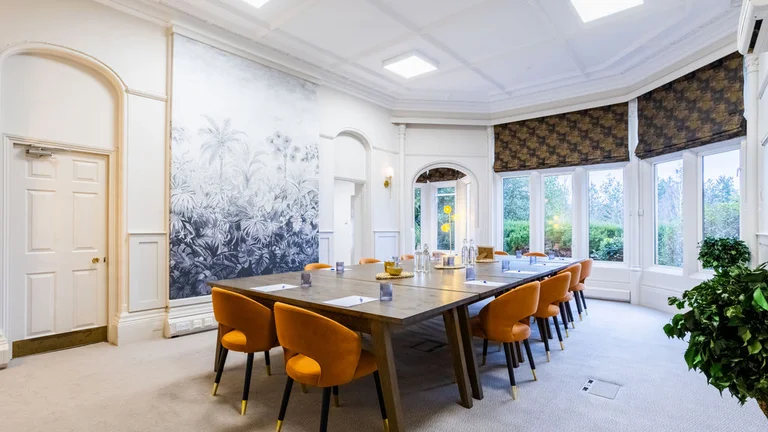
Best for: Executive meetings, small group discussions, interviews
In the boardroom set-up, participants are seated around a single rectangular or oval table. This classic layout is ideal for small to medium-sized groups and encourages face-to-face interaction.
Benefits:
- Encourages discussion and decision-making
- Ideal for meetings with a clear agenda
- Provides a professional and intimate atmosphere
Drawbacks:
- Not as suitable for large groups
- Difficult for presenters to move around the room
- Limited visibility for visual aids unless screens are placed strategically
2. U-Shape/Horseshoe Style
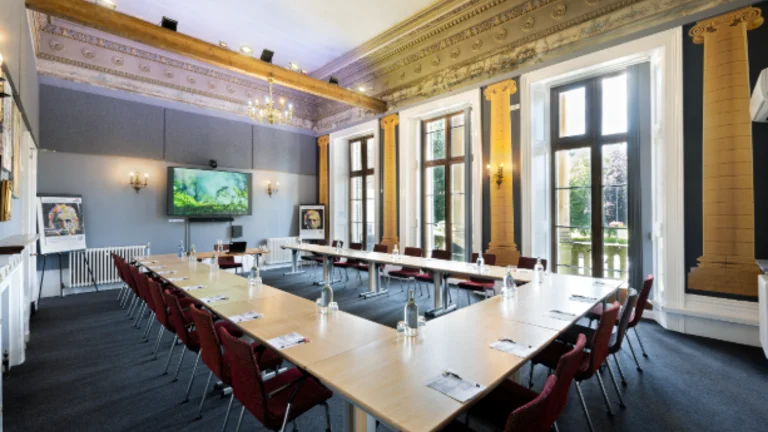
Best for: Presentations, training sessions, video conferencing
The U-shape layout arranges tables in a horseshoe or “U” shape with chairs placed around the outer edges. This set up works well for presentations where the facilitator needs to engage with participants directly and move within the open area.
Benefits:
- Clear visibility of the presenter and screen
- Facilitates interaction between the presenter and attendees
- Great for training and workshops with group participation
Drawbacks:
- Not ideal for very large groups
- Can be space-intensive
- May limit participant collaboration with those on the opposite sides
3. Classroom Style
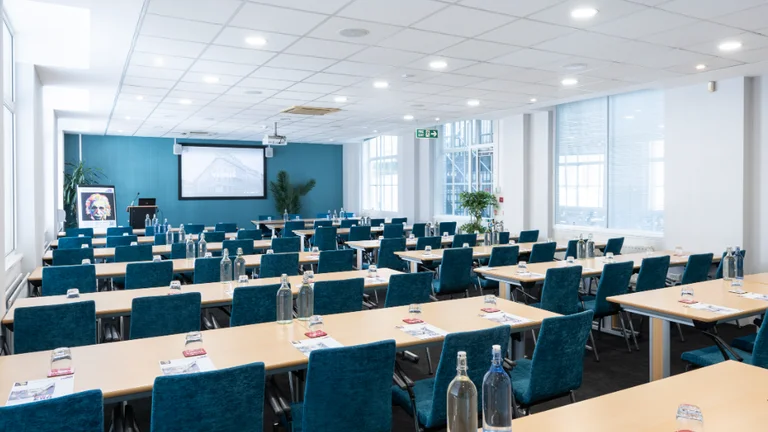
Best for: Seminars, educational sessions, note-taking workshops
The classroom layout features rows of tables and chairs all facing the front of the room. It mimics a traditional classroom setting and is best used for lecture-style meetings or when attendees need to take notes or use laptops.
Benefits:
- Supports long-form presentations and seminars
- Comfortable for taking notes or using devices
- Easy to scale for larger audiences
Drawbacks:
- Limited interaction among attendees
- Can feel formal and rigid
- The presenter may feel distanced from participants
4. Theatre Style
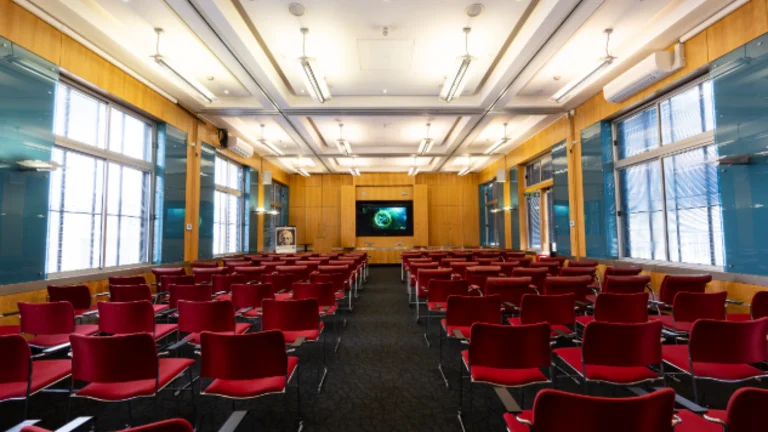
Best for: Large conferences, keynotes, product launches
In theatre style, rows of chairs are arranged in straight lines facing the front of the room. This set-up is space-efficient and ideal for accommodating large groups without tables.
Benefits:
- Maximises seating capacity
- Perfect for one-way presentations or speeches
- Quick and easy to set up
Drawbacks:
- No workspace for writing or using laptops
- Limited interaction between participants
- Can feel impersonal for small groups
5. Cabaret Style
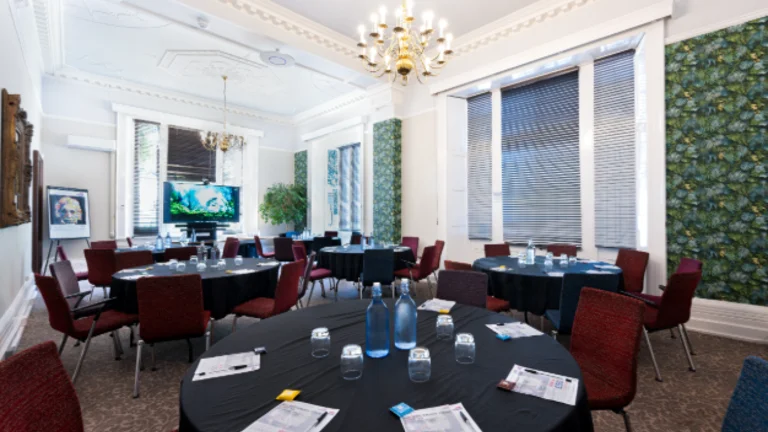
Best for: Collaborative workshops, networking events, training days
Cabaret set up features round tables with chairs placed around three sides, leaving one side open to face the presenter or screen. This layout encourages group discussion while keeping focus on the front of the room.
Benefits:
- Encourages teamwork and networking
- Combines collaboration with presentation visibility
- Comfortable for longer sessions with meals or refreshments
Drawbacks:
- Space-consuming compared to other layouts
- Not suitable for very large audiences
- Visibility of screens can be limited for some attendees
6. Private Dining/Banquet Style
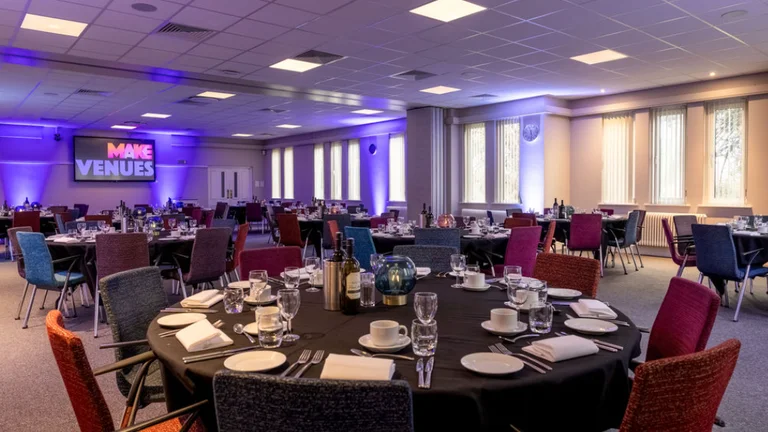
Best for: Corporate dinners, award ceremonies, gala events
Banquet style involves round tables with chairs on all sides, suitable for seated meals and formal social gatherings. It fosters social interaction and is a popular choice for evening functions and celebrations.
Benefits:
- Promotes casual networking and mingling
- Works well with catering or plated meals
- Aesthetic and formal for evening events
Drawbacks:
- Doesn’t prioritise the visibility of speakers or screens
- Not ideal for presentations or structured meetings
- Audio may not carry well around round tables
Other Things to Consider When Setting Up a Conference Room
Quality of Desks:
While the overall conference room set up plays a vital role in the success of your meeting, the quality and design of desks and tables can make a significant difference in comfort and functionality. Make sure to choose high quality and durable desks.
Technology and Equipment:
A conference room can be improved significantly by adding the right technology and equipment. They can be enhanced with:
- Display screens and projectors: Ideal for presentations and video calls.
- Reliable internet: With video calls common in conferences, it’s vital you have a reliable internet connection so video calls don’t lag or have connection issues.
- Whiteboards/smartboards: Being able to write down notes and brainstorm ideas can be beneficial for some conferences.
- Power outlets and charging stations: Being able to charge multiple devices like laptops and phones can vastly improve a conference room and ensure everyone has access to the devices they need. Connecting a laptop to a TV with a HDMI cable is one of the easiest ways to share your screen during a conference.
- HDMI cables and adapters: Connecting a laptop to a TV with a HDMI cable is one of the easiest ways to share your screen during a conference.
Soundproofing:
Having conference rooms that are soundproofed can help avoid outside noise interrupting or distracting people. Sound absorbing panels and ceiling tiles can help improve soundproofing in a room.
Lighting:
Natural light in a room can be great but it’s important to avoid glare on screens. Blinds should be considered in rooms that get direct sunlight so they can be closed if needed.
Supplies & Extras:
Pens and notepads are ideal for people wanting to take notes during a conference. Having a clock that is visible can also help keep your meeting on schedule. Refreshments like water, tea and coffee also help keep people comfortable and hydrated.
Clean and comfortable rooms:
A conference room should be clean to ensure everyone can focus and is not distracted by clutter.
- Rubbish bins and recycling bins in rooms encourage guests to throw away their rubbish.
- Temperature control of specific rooms is a great enhancement if possible. Getting the temperature at a comfortable level can help maintain people’s focus during a conference. If it gets too hot or too cold, it’s very likely people will get distracted.
- Hand sanitiser and tissues are always a good thing to have available.
Choosing the Right Conference Room Set Up with Make Venues
The key to selecting the best conference room set up is to align it with your event goals, audience size, and meeting style. If you're planning a high-level board meeting, a collaborative training session, or a large-scale conference, our versatile spaces in London, Bristol, and Leamington Spa are designed to meet your needs.
Each venue is fully equipped with adaptable layouts, state-of-the-art technology, and a dedicated team to support you from planning to execution. Get in touch with us today to explore our spaces and services.
You May Also Like:
18 Fun Meeting Ideas to Inspire Your Team
15 Icebreaker Games for Small Groups
How to Plan an Event Successfully: The Event Planning Checklist
